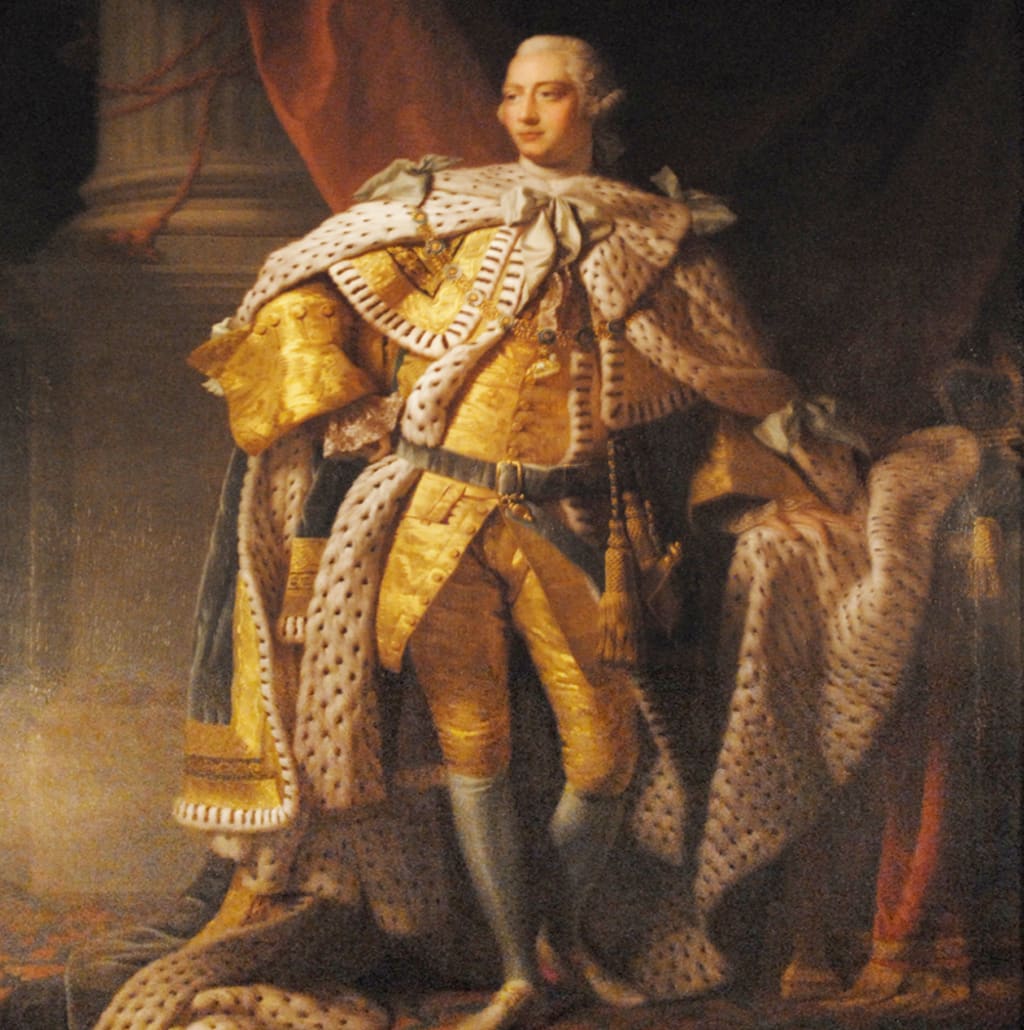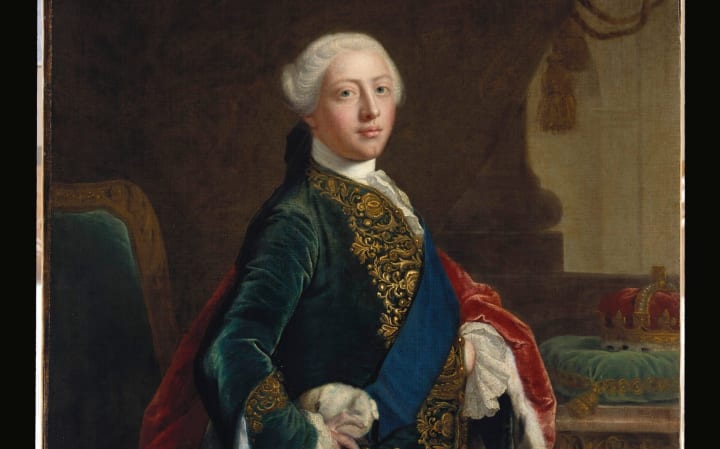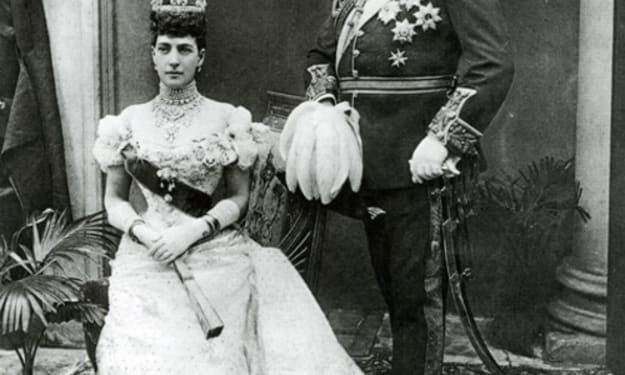A STUDY IN THE GEORGIAN ERA
Who Were The Kings Of The Georgian Era?

Who were the Kings of the Georgian Era? As the name suggests, all but one had the name George, and this Era is a period in English history from 1714 to c.1831-37. The Hanoverian Kings were King Georges I to IV, but also included the short reign of William IV. Queen Victoria came to the throne after this king and she had an Era named after her, the Victorian Era.
KING GEORGE I was the King of Great Britain from 1714 until his death in 1727. George was born in 1660 in the city of Hanover. He was the eldest son of Ernest Augustus and his wife Sophia of the Palatine. Sophia was the granddaughter of King James I of England through her mother, Elizabeth of Bohemia. So it was through is mother that this George came to the throne. In 1682, George married his first cousin, Sophia Dorothea of Celle. They had two children = George Augustus and Sophia Dorothea (who became Queen of Prussia). The marriage was dissolved on the grounds that Sophia Dorothea had abandoned her husband. William III and Queen Anne of England did without issue and George became King George I. He arrived in England in September 1714 and was crowned at Westminster Abbey on October 1714. George mainly lived in Great Britain, although he did visit his home in Hanover several times, in total George spent about one fifth of his reign as King in Germany. George rarely attended meetings of the cabinet, most of his communications were in private, and he only exercised substantial influence with respect to British foreign policy. He wanted to protect British trade. King George I did of a stroke in 1727, on a visit to Hanover. He is buried at the 19th century mausoleum of King Ernest Augustus in the Berggarten.
KING GEORGE II was King of Great Britain from 1727 until his death in 1760. He was born in the city of Hanover in Germany in 1683. As King from 1727, King George II exercised little control over British domestic policy, which was largely controlled by the Parliament of Great Britain. George was taught French, German, English and Italian and was schooled in genealogy, military history and battle tactics. He was naturalized as an English subject in 1705. In the same year, George married Caroline of Ansbach at Herrenhausen. They had several children. King George II was 43 years old when he came to the throne and was crowned in Westminster Abbey in October 1727. In November 1737, George’s wife Caroline died and George was affected by her death. His eldest son died in 1751 making his grandson, Prince George, heir apparent. At the age of 77, King George II died in October 1760 and was buried in Westminster Abbey. He had lived longer than any of his English predecessors. In 1757, King George II donated the Royal Library to the British Museum.
KING GEORGE III was King of Great Britain from 1760 until his death in 1820. He was the third British monarch of the House of Hanover. He was born in Great Britain, spoke English as his first language and never visited Hanover. George was born in 1738 in London and was the grandson of King George II, being the son of Prince Frederick, Prince of Wales, and Augusta of Saxe-Gotha. His studies included English, German, science, astronomy, mathematics and constitutional law. His father, the Prince of Wales, died from a lung injury at the age of 44 and George became heir apparent to the throne. King George III became king at the age of 22. In 1761, George married the Princess Charlotte of Mecklenberg-Strelitz. Two weeks later, they were both crowned at Westminster Abbey. The couple enjoyed a genuinely happy marriage until George’s mental illness struck. They had 15 children, nine sons and six daughters. In 1762, George purchased Buckingham House (now Buckingham Palace) for use as a family retreat. He spent his entire life in Southern England. In the 1790s, the king and his family took holidays at Weymouth, Dorset, which he thus popularized as one of the first seaside resorts in England. In his accession speech to Parliament, King George III proclaimed: “Born and educated in this country, I glory in the name of Britain.” King George III first became ill in 1765 and the Prince of Wales became Regent in 1810. By the end of 1811, George became permanently insane and lived in seclusion at Windsor Castle until his death. After his death in 1820, King George III was buried in St. George’s Chapel, Windsor Castle. King George III was succeeded by his son King George IV. King George III lived for 81 years and 239 days and reigned for 59 years and 96 days. Only Queen Victoria and Elizabeth II have since lived and reigned longer.

KING GEORGE IV was King of Great Britain from 1820 until his death ten years later. From 1811, until his accession to the throne, he served as Prince Regent during his father’s final mental illness. George was born in London in 1762 and was the eldest child if King George III and Charlotte of Mecklenburg-Streletz. His studies included French, German, Italian and English. George married Maria Fitzherbert (twice widowed and a Roman Catholic) in 1785, without his father’s (King George III) consent. This marriage was not looked at as valid and in 1795, the Prince married his cousin, the Princess Caroline of Brunswick. This marriage was disastrous as each party was unsuited to the other. However, the Prince remained attached to Maria Fitzherbert. Despite having numerous illegitimate children, the Prince only had one legitimate daughter, the Princess Charlotte, who was placed in the care of the king, George III. Her mother, the Princess Caroline’s conduct had been extraordinarily indiscreet. The Prince became Prince Regent in 1811, his father’s mental illness having finally taken over him. The Regent let his ministers take full charge of government affairs, playing a lesser role than his father. King George IV came to the throne when he was 57 years old and he was obese and possibly addicted to laudanum. Hi coronation was at Westminster Abbey in 1821. He excluded his wife, Caroline, from the coronation, they had separated in 1796. He refused to recognize her as Queen Consort. Caroline died on 7th August, 1821, and often stated that she had been poisoned. King George IV spent most of his reign in seclusion at Windsor Castle, (like his father) but continued to intervene in politics. King George IV’s heavy drinking and indulgent lifestyle had taken their toll on his health by the late 1820s. King George IV died in 1830 at Windsor Castle, where he was buried in St. George’s Chapel. Princess Charlotte, his only legitimate child, had died from post-partum complications in 1817, after delivering a stillborn son. The throne now passed to King George III’s third son, Prince William, Prince Frederick, had died childless in 1827.
KING WILLIAM IV was King of Great Britain from 1820 until his death in 1837. William was the last monarch of the House of Hanover. He was nicknamed the “Sailor King” having spent most of his youth in the Navy. In 1827, William was appointed Britain’s Lord High Admiral. William was born at Buckingham House in 1765, the third son of King George III and Queen Charlotte. Having two older brothers, he was not expected to inherit the Crown. By the age of 13, William joined the Navy. From 1791, he lived with an Irish actress, Dorothea Bland, and they lived quietly together, having ten illegitimate children, five sons and five daughters. The affair lasted for 20 years, finishing in 1811. In 1818, William married the Princess Adelaide of Saxe-Meiningen who was, at 25, half of William’s age. Their marriage lasted 20 years until William’s death and it was a happy marriage. They had several children but all of them died at a young age. King William IV was 64 years of age when he ascended to the throne. Unlike his brother, William was unassuming and discouraged pomp and ceremony. He was a conscientious worker. He did his best to endear himself to the people. King William IV’s coronation was in 1832. King William and Queen Adelaide were fond of their niece, the Princess Victoria of Kent, who was now the heir apparent. King William IV died in 1837 at Windsor Castle, where he was buried, The Crown now passed to the Princess Victoria of Kent, the only child of Edward Augustus, the Duke of Kent, King George III’s fourth son. During King William IV’s reign, the British Parliament enacted major reforms, including the Factory Act of 1833 (preventing child labour), the Slavery Abolition Act 1833 (emancipating slaves in the colonies), and the Poor Law Amendment Act 1834 (standardizing provision for the destitute).
Thus, with these five Kings is set the “Scene” for the Georgian Era.
(A lot of this information comes from Wikipedia.)
Look out for more articles on The Georgian Era.
About the Creator
Ruth Elizabeth Stiff
I love all things Earthy and Self-Help
History is one of my favourite subjects and I love to write short fiction
Research is so interesting for me too
Enjoyed the story? Support the Creator.
Subscribe for free to receive all their stories in your feed. You could also pledge your support or give them a one-off tip, letting them know you appreciate their work.






Comments
There are no comments for this story
Be the first to respond and start the conversation.